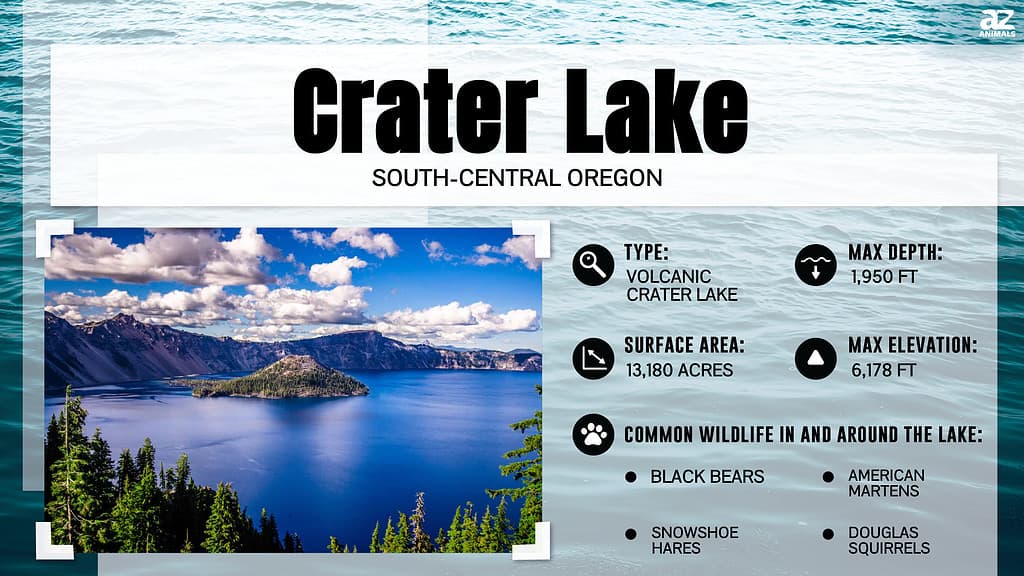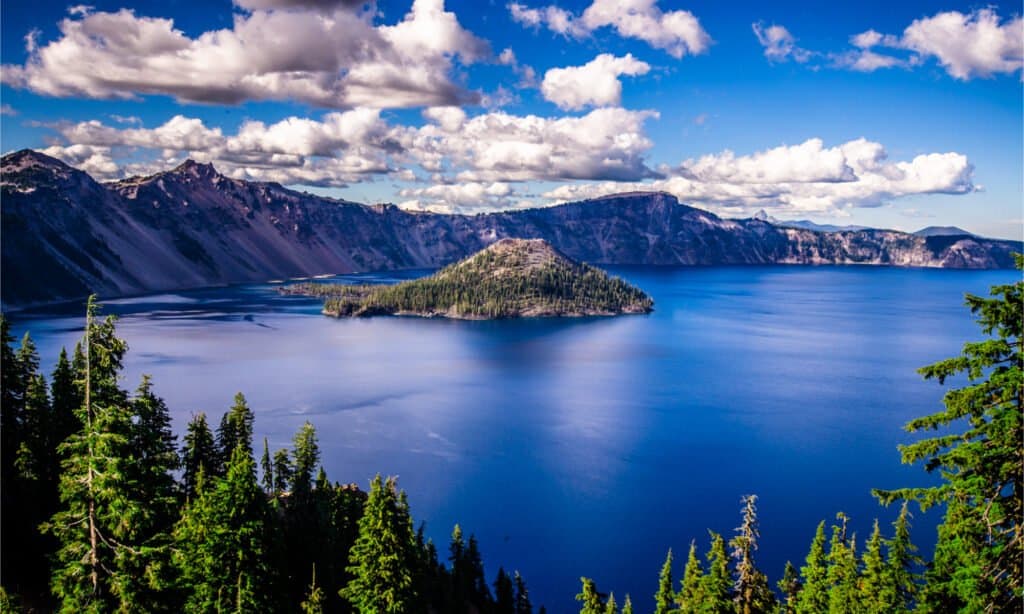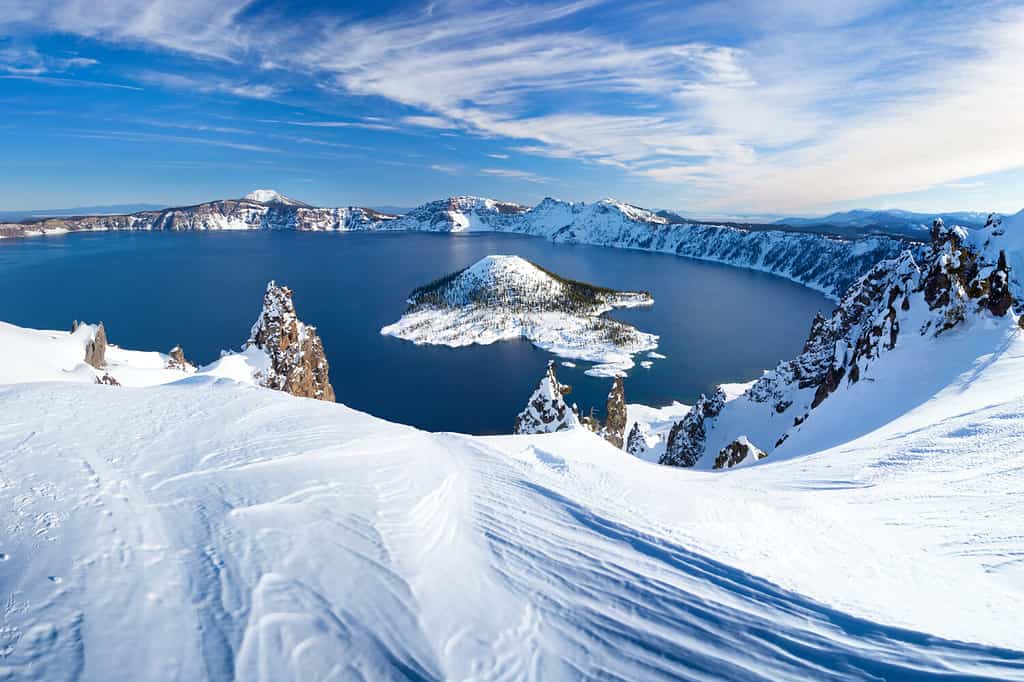Crater Lake is a very well-known lake in south-central Oregon. It’s extremely clear, clean, and beautiful. Crater Lake is also the deepest lake in the United States! This Volcanic crater lake is within Crater Lake National Park, established in 1902. If you’d like to visit this lovely lake, you’ll need to hike the Cleetwood Cove Trail to the water. Are you interested in learning more about this picture-perfect lake? Follow along to learn about Crater Lake.

Location
Crater Lake is in south-central Oregon within Crater Lake National Park. This lake is in Klamath County, which has a population of nearly 70,000.
History

Crater Lake is within Crater Lake National Park.
©Pung/Shutterstock.com
There is a long history between people and Carter Lake. Actually, Native Americans traveled and lived in this area before the eruption of Mount Mazama. While scientists have found artifacts underneath the eruption site, there is no evidence suggesting that Native Americans permanently lived on the mountain or lake. Mount Mazama erupted over 7,700 years ago. To the Klamath, this lake is a sacred place. The Klamath likely witnessed the eruption, as there are oral records of a battle between the sky god and the god of the underworld.
Crater Lake didn’t encounter European settlers, though, until 1853 when John Wesley Hillman financed a gold prospecting trip. When he and his crew found the lake, he called it the “Deep Blue Lake.” They didn’t find gold, and a decade later, the lake was discovered again by Oregon prospectors. They were also starstruck by the deep blueness of the lake.
In 1870, William Gladstone Steel went searching for the deep blue lake he read about in a newspaper. He saw it 15 years later and worked to establish the stunning lake as a national park. Crater Lake National Park was established on May 22, 1902, nearly twenty years after Steel laid eyes on it.
Size

Crater Lake is 6 miles long and 5 miles wide, with an overall surface area of 20.6 square miles.
©Matthew Connolly/Shutterstock.com
Now that we know a little of the history between Crater Lake and its people, we can discuss its size. Crater Lake is 6 miles long and 5 miles wide. The overall surface area of this lake is 20.6 square miles. This circular lake has 21.8 miles of shore length and sits at an elevation of 6,178 feet.
Depth
Crater Lake is the deepest lake in the United States and the second deepest lake in North America. The average depth of the ultra-clear lake is 1,148 feet. The maximum recorded depth of Crater Lake is 1,949 feet. Even though this lake is so deep, the water is still extremely clear! This is because the water within the lake comes from rain and snow since it’s a collapsed mountain. However, you can read more about this in the geology section of this article.
Fishing
Officials encourage fishing in Carter Lake since none of the fish species are native. Seven fish species were stocked in the lake from 1888 and 1941. Currently, there are about 60,000 kokanee salmon and rainbow trout. A fishing license isn’t required to fish in the national park. It’s important to note that no organic bait is allowed. Park officials only allow artificial bait to not accidentally introduce non-native organisms. You can also fish from the docks and shore of Wizard Island.

Swimming is allowed from the docks and shore of Wizard Island.
©iStock.com/Kalichka
Geology
This lake’s geology is unique. It took thousands of years to form and fill. Crater Lake wouldn’t exist without the eruption of Mount Mazama. This volcano formed over a period of at least 400,000 years. Crater Lake’s history, though, began about 6,000 and 8,000 years ago when a massive eruption caused the caldera. Mount Mazama was 12,000 feet tall. Volcanic features like Wizard Island formed thousands of years later with other eruptions. Wizard Island is about 755 feet tall, but its height varies depending on the lake’s water level. The island sits at an elevation of 6,933 feet. Rain and snow for thousands of years have filled Crater Lake, causing the water to run clean and clear. There are no flowing streams to bring in debris. Light also penetrates up to 131 feet of water in this lake.
Boating and Other Activities
So, you’re visiting Crater Lake. What is there to do? Can you swim or sail? Swimming is a popular activity in Crater Lake. There aren’t many risks, including dangerous animals. Crater Lake, however, is very cold! The best time to swim in this lake is from June through September. It’s important to note that you can’t swim in all parts of the lake. There is only one designated area. Visitors must use the Cleetwood Cove Trail to reach the designated swimming area. It’s also important you don’t bring additional items for swimming to protect the water’s cleanliness and clarity. For example, scuba equipment is not allowed. You also can’t bring your own kayak or paddleboard.
Swimming and fishing aren’t the only activities to enjoy within Crater Lake. Visitors can also visit Wizard Island, which is in the center of the deep blue lake. This 763-foot cinder cone is accessible through a boat tour, which typically allows visitors to enjoy the island for up to 6 hours. Tours depart from the Cleetwood Cove Boat Dock, but hours and prices vary. While on Wizard Island, you can fish and explore. You can also hike the Wizard Island Summit Trail to the top of the cinder cone.
About Crater Lake National Park
This deep blue lake is within Crater Lake National Park, the fifth oldest national park in the country. It’s located in Klamath County, Oregon, near Klamath Falls. The surface area of this lovely national park is 183,224 acres. Over 700,000 people visit Crater Lake National Park every year, and for a good reason!
The air is generally dry in the park. The highest recorded temperature is 100 °F, while the coldest is −21°F. Although Crater Lake is an important part of the national park, there are other things to see. You can hike multiple trails, including the Watchman Peak Trail, Lightning Spring Trail, Castle Crest Wildflower Garden Trail, Plaikni Falls Trail, and Garfield Peak Trail. None of these trails are more than two miles long.
The Garfield Peak trail is one of the more challenging trails in the national park. It’s about 1.7 miles long and gains 1,000 feet of elevation. It’s a beautiful trail that offers stunning views of multiple Crater Lake features, including Phantom Ship Island and Wizard Island.
If you’re looking for camping options while visiting this stunning national park, you can use the Mazama Campground during summer. The exact open dates depend on the snow and weather. In this campground are 214 sites, and 75 are for RVs only.

Camping in Crater Lake National Park is allowed in the Mazama Campground.
©iStock.com/gorodenkoff
Animals in Crater Lake National Park
While Crater Lake has no indigenous fish species, this doesn’t mean there aren’t many animals that call the surrounding forest home. In Crater Lake National Park, you have the chance to see large animals like black bears. These large mammals are more common during fall and spring, before and after hibernation. Apart from bears, visitors may encounter snowshoe hares, American pikas, bobcats, and mountain lions.
Mammals aren’t the only animals you may spot while hiking a trail at the park. You’re more likely to see birds like the dusky flycatcher, mountain bluebird, Western robin, great egret, and brown pelican. While you’re more likely to see birds, some amphibians live within the national park. These include the Pacific treefrog, rough-skinned newt, Crater Lake newt, and tailed frog.
The photo featured at the top of this post is © iStock.com/Photographer and videographer from Ukraine
Thank you for reading! Have some feedback for us? Contact the AZ Animals editorial team.






